A Remote-Sensing Method to Estimate Bulk Refractive Index of Suspended Particles from GOCI Satellite Measurements over Bohai Sea and Yellow Sea
Abstract
Featured Application
Abstract
1. Introduction
2. Data and Methods
2.1. The Study Water Areas
2.2. Bio-Optical Measurements
2.3. np Calculation
2.4. GOCI Data Collection and Processing
2.5. Development of np Estimation Model
2.5.1. Estimation of TSM from
2.5.2. Estimation of and from
2.5.3. Derivation of the PSD Slope, j, from TSM
2.6. Performance Metrics
3. Results
3.1. Water Bio-Optical Conditions
3.2. Validation of np Estimation Model
3.3. Model Application to Satellite Data
4. Discussion
4.1. Advantages and Disadvantages of the np Model
4.2. Comparison with the Method Using a Straight Bp Empirical Model
4.3. Driving Factors of np Spatiotemporal Variation
4.4. Implications for Marine Environmental Changes
5. Conclusions
Author Contributions
Funding
Acknowledgments
Conflicts of Interest
References
- Stramski, D.; Bricaud, A.; Morel, A. Modeling the inherent optical properties of the ocean based on the detailed composition of the planktonic community. Appl. Opt. 2001, 40, 2929. [Google Scholar] [CrossRef] [PubMed]
- Twardowski, M.S.; Emmanuel, B.; Macdonald, J.B.; Scott, P.W.; Barnard, A.H.; Zaneveld, J.R.V. A model for estimating bulk refractive index from the optical backscattering ratio and the implications for understanding particle composition in case I and case II waters. J. Geophys. Res. Atmos. 2001, 106, 14129–14142. [Google Scholar] [CrossRef]
- Woźniak, S.B.; Stramski, D. Modeling the optical properties of mineral particles suspended in seawater and their influence on ocean reflectance and chlorophyll estimation from remote sensing algorithms. Appl. Opt. 2004, 43, 3489–3503. [Google Scholar] [CrossRef] [PubMed]
- Nasiha, H.J.; Shanmugam, P.; Hariharasudhan, V.G. A new inversion model to estimate bulk refractive index of particles in coastal oceanic waters: Implications for remote sensing. IEEE J. Sel. Top. Appl. Earth Obs. Remote Sens. 2014, 7, 3069–3083. [Google Scholar] [CrossRef]
- Nasiha, H.J.; Shanmugam, P. Estimating the bulk refractive index and related particulate properties of natural waters from remote-sensing data. IEEE J. Sel. Top. Appl. Earth Obs. Remote Sens. 2015, 8, 5324–5335. [Google Scholar] [CrossRef]
- Pak, H.; Ronald, J.; Zaneveld, V. Method for the determination of the index of refraction of particles suspended in the ocean. Domest. Anim. Endocrinol. 2010, 38, 115–125. [Google Scholar]
- Yentsch, C.S. A note on the fluorescence characteristics of particles that pass through glass-fiber filters. Limnol. Oceanogr. 1983, 28, 597–599. [Google Scholar] [CrossRef]
- Agrawal, Y.C.; Pottsmith, H.C. Instruments for particle size and settling velocity observations in sediment transport. Mar. Geol. 2000, 168, 89–114. [Google Scholar] [CrossRef]
- Jonasz, M.; Fournier, G.R. Light Scattering by Particles in Water; ELSEVIER: Amsterdam, The Netherlands, 2017; pp. 611–681. [Google Scholar]
- Gitelson, A.A.; Dall’Olmo, G.; Moses, W.; Rundquist, D.C.; Barrow, T.; Fisher, T.R.; Gurlin, D.; Holz, J. A simple semi-analytical model for remote estimation of chlorophyll-a in turbid waters: Validation. Remote Sens. Environ. 2008, 112, 3582–3593. [Google Scholar] [CrossRef]
- Hu, C.; Lee, Z.; Franz, B. Chlorophyll aalgorithms for oligotrophic oceans: A novel approach based on three-band reflectance difference. J. Geophys. Res. Ocean. 2012, 117, C01011. [Google Scholar] [CrossRef]
- O’Reilly, J.E.; Maritorena, S.; Siegel, D.A.; O’Brien, M.C.; Toole, D.; Mitchell, B.G.; Kahru, M.; Chavez, F.P.; Strutton, P.; Cota, G.F. Ocean color chlorophyll a algorithms for seawifs, oc2, and oc4: Version 4. SeaWiFS Postlaunch Calibration Valid. Anal. 2000, 3, 9–23. [Google Scholar]
- Tilstone, G.H.; Angel-Benavides, I.M.; Pradhan, Y.; Shutler, J.D.; Groom, S.; Sathyendranath, S. An assessment of chlorophyll-a algorithms available for seawifs in coastal and open areas of the bay of bengal and arabian sea. Remote Sens. Environ. 2011, 115, 2277–2291. [Google Scholar] [CrossRef]
- Werdell, P.J.; Bailey, S.W.; Franz, B.A.; Harding, L.W., Jr.; Feldman, G.C.; McClain, C.R. Regional and seasonal variability of chlorophyll-a in chesapeake bay as observed by seawifs and MODIS-Aqua. Remote Sens. Environ. 2009, 113, 1319–1330. [Google Scholar] [CrossRef]
- Kishino, M.; Tanaka, A.; Ishizaka, J. Retrieval of chlorophyll a, suspended solids, and colored dissolved organic matter in tokyo bay using aster data. Remote Sens. Environ. 2005, 99, 66–74. [Google Scholar] [CrossRef]
- Nechad, B.; Ruddick, K.G.; Park, Y. Calibration and validation of a generic multisensor algorithm for mapping of total suspended matter in turbid waters. Remote Sens. Environ. 2010, 114, 854–866. [Google Scholar] [CrossRef]
- Ondrusek, M.; Stengel, E.; Kinkade, C.S.; Vogel, R.L.; Keegstra, P.; Hunter, C.; Kim, C. The development of a new optical total suspended matter algorithm for the chesapeake bay. Remote Sens. Environ. 2012, 119, 243–254. [Google Scholar] [CrossRef]
- Dogliotti, A.I.; Ruddick, K.G.; Nechad, B.; Doxaran, D.; Knaeps, E. A single algorithm to retrieve turbidity from remotely-sensed data in all coastal and estuarine waters. Remote Sens. Environ. 2015, 156, 157–168. [Google Scholar] [CrossRef]
- Qiu, Z.; Zheng, L.; Zhou, Y.; Sun, D.; Wang, S.; Wu, W. Innovative goci algorithm to derive turbidity in highly turbid waters: A case study in the zhejiang coastal area. Opt. Express 2015, 23, A1179. [Google Scholar] [CrossRef]
- Chen, J.; He, X.; Zhou, B.; Pan, D. Deriving colored dissolved organic matter absorption coefficient from ocean color with a neural quasi-analytical algorithm. J. Geophys. Res. Ocean. 2017, 122, 8543–8556. [Google Scholar] [CrossRef]
- Mannino, A.; Russ, M.E.; Hooker, S.B. Algorithm development and validation for satellite-derived distributions of doc and cdom in the U.S. Middle atlantic bight. J. Geophys. Res. Ocean. 2008, 113. [Google Scholar] [CrossRef]
- Zhu, W.; Yu, Q.; Tian, Y.Q.; Becker, B.L.; Zheng, T.; Carrick, H.J. An assessment of remote sensing algorithms for colored dissolved organic matter in complex freshwater environments. Remote Sens. Environ. 2014, 140, 766–778. [Google Scholar] [CrossRef]
- Suresh, T.; Desa, E.; Mascaranahas, A.; Matondkar, S.G.P.; Naik, P.; Nayak, S.R. An empirical method to estimate bulk particulate refractive index for ocean satellite applications. In Remote Sensing of the Marine Environment; International Society for Optics and Photonics: Bellingham WA, USA, 2006; Volume 6406, p. 64060B. [Google Scholar]
- Sun, D.; Qiu, Z.; Hu, C.; Wang, S.; Wang, L.; Zheng, L.; Peng, T.; He, Y. A hybrid method to estimate suspended particle sizes from satellite measurements over Bohai Sea and Yellow Sea. J. Geophys. Res. Ocean. 2016, 121, 6742–6761. [Google Scholar] [CrossRef]
- Sun, D.; Huan, Y.; Qiu, Z.; Hu, C.; Wang, S.; He, Y. Remote sensing estimation of phytoplankton size classes from GOCI satellite measurements in Bohai Sea and Yellow Sea. J. Geophys. Res. Ocean. 2017, 122, 8309–8325. [Google Scholar] [CrossRef]
- Voss, K.J. A spectral model of the beam attenuation coefficient in the ocean and coastal areas. Limnol. Oceanogr. 1992, 37, 501. [Google Scholar] [CrossRef]
- Roesler, C.S.; Boss, E. Spectral beam attenuation coefficient retrieved from ocean color inversion. Geophys. Res. Lett. 2003, 30. [Google Scholar] [CrossRef]
- Boss, E.; Pegau, W.S.; Gardner, W.D.; Zaneveld, J.R.V.; Barnard, A.H.; Twardowski, M.S.; Chang, G.C.; Dickey, T.D. Spectral particulate attenuation and particle size distribution in the bottom boundary layer of a continental shelf. J. Geophys. Res. Ocean. 2001, 106, 9509–9516. [Google Scholar] [CrossRef]
- Wang, M.; Gordon, H.R. A simple, moderately accurate, atmospheric correction algorithm for SeaWiFS. Remote Sens. Environ. 1994, 50, 231–239. [Google Scholar] [CrossRef]
- Goodin, D.G.; Harrington, J.A., Jr.; Nellis, M.D.; Rundquist, D.C. Mapping reservoir turbidity patterns using spot-hrv data. Geocarto Int. 1996, 11, 71–78. [Google Scholar] [CrossRef]
- Ouillon, S.; Douillet, P.; Petrenko, A.; Neveux, J.; Dupouy, C.; Froidefond, J.M.; Andréfouët, S.; Muñoz-Caravaca, A. Optical algorithms at satellite wavelengths for total suspended matter in tropical coastal waters. Sensors 2008, 8, 4165–4185. [Google Scholar] [CrossRef]
- He, X.; Bai, Y.; Pan, D.; Huang, N.; Dong, X.; Chen, J.; Chen, C.T.A.; Cui, Q. Using geostationary satellite ocean color data to map the diurnal dynamics of suspended particulate matter in coastal waters. Remote Sens. Environ. 2013, 133, 225–239. [Google Scholar] [CrossRef]
- Wang, S.; Huan, Y.; Qiu, Z.; Sun, D.; Zhang, H.; Zheng, L.; Xiao, C. Remote Sensing of Particle Cross-Sectional Area in the Bohai Sea and Yellow Sea: Algorithm Development and Application Implications. Remote Sens. 2016, 8, 841. [Google Scholar] [CrossRef]
- Niroumand-Jadidi, M.; Bovolo, F.; Bruuzone, L. Novel Spectra-Derived Features for Empirical Retrieval of Water Quality Parameters: Demonstrations for OLI, MSI, and OLCI Sensors. IEEE Trans. Geosci. Remote Sens. 2019, 57, 10285–10300. [Google Scholar] [CrossRef]
- Kirk, J. Monte carlo study of the nature of the underwater light field in, and the relationships between optical properties of, turbid yellow waters. Mar. Freshw. Res. 1981, 32, 517–532. [Google Scholar] [CrossRef]
- Sun, D.; Hu, C.; Qiu, Z.; Cannizzaro, J.P.; Barnes, B.B. Influence of a red band-based water classification approach on chlorophyll algorithms for optically complex estuaries. Remote Sens. Environ. 2014, 155, 289–302. [Google Scholar] [CrossRef]
- Davies-Colley, R.J.; Nagels, J.W. Predicting light penetration into river waters. J. Geophys. Res. Biogeosci. 2015, 113, 375–402. [Google Scholar] [CrossRef]
- Kearns, M.; Ron, D. Algorithmic stability and sanity-check bounds for leave-one-out cross-validation. Neural Comput. 1997, 11, 1427–1453. [Google Scholar] [CrossRef]
- Cawley, G.C. Leave-one-out cross-validation based model selection criteria for weighted ls-svms. In Proceedings of the 2006 IEEE International Joint Conference on Neural Networks, Vancouver, BC, Canada, 16–21 July 2006. [Google Scholar]
- Babin, M.; Morel, A.; Fournier-Sicre, V.; Fell, F.; Stramski, D. Light scattering properties of marine particles in coastal and open ocean waters as related to the particle mass concentration. Limnol. Oceanogr. 2003, 48, 843–859. [Google Scholar] [CrossRef]
- Loisel, H.; Mériaux, X.; Berthon, J.F.; Poteau, A. Investigation of the optical backscattering to scattering ratio of marine particles in relation to their biogeochemical composition in the eastern english channel and southern north sea. Limnol. Oceanogr. 2007, 52, 739–752. [Google Scholar] [CrossRef]
- Whitmire, A.L.; Boss, E.; Cowles, T.J.; Pegau, W.S. Spectral variability of the particulate backscattering ratio. Opt. Express 2007, 15, 7019–7031. [Google Scholar] [CrossRef]
- Snyder, W.A.; Arnone, R.A.; Davis, C.O.; Goode, W.; Gould, R.W.; Ladner, S.; Lamela, G.; Rhea, W.J.; Stavn, R.; Sydor, M. Optical scattering and backscattering by organic and inorganic particulates in U.S. Coastal waters. Appl. Opt. 2008, 47, 666. [Google Scholar] [CrossRef]
- Zhang, M.; Tang, J.; Song, Q.; Dong, Q. Backscattering ratio variation and its implications for studying particle composition: A case study in yellow and east china seas. J. Geophys. Res. Ocean. 2010, 115. [Google Scholar] [CrossRef]
- Doña, C.; Sánchez, J.M.; Caselles, V.; Domínguez, J.A.; Camacho, A. Empirical relationships for monitoring water quality of lakes and reservoirs through multispectral images. IEEE J. Sel. Top. Appl. Earth Obs. Remote Sens. 2014, 7, 1632–1641. [Google Scholar] [CrossRef]
- Wang, X.; Fu, L.; He, C. Applying support vector regression to water quality modelling by remote sensing data. Int. J. Remote Sens. 2011, 32, 8615–8627. [Google Scholar] [CrossRef]
- Yang, W.; Matsushita, B.; Chen, J.; Fukushima, T. Estimating constituent concentrations in case ii waters from meris satellite data by semi-analytical model optimizing and look-up tables. Remote Sens. Environ. 2011, 115, 1247–1259. [Google Scholar] [CrossRef]
- Boss, E.; Pegau, W.S.; Lee, M.; Twardowski, M.; Shybanov, E.; Korotaev, G.; Baratange, F. Particulate backscattering ratio at leo 15 and its use to study particle composition and distribution. J. Geophys. Res. Ocean. 2004, 109. [Google Scholar] [CrossRef]
- Sullivan, J.M.; Twardowski, M.S.; Donaghay, P.L.; Freeman, S.A. Use of optical scattering to discriminate particle types in coastal waters. Appl. Opt. 2005, 44, 1667–1680. [Google Scholar] [CrossRef]
- Cui, T.; Zhang, J.; Ma, Y.; Zhao, W.; Sun, L. The study on the distribution of suspended particulate matter in the bohai sea by remote sensing. Acta Oceanol. Sin. 2009, 31, 10–18. [Google Scholar]
- Cui, T.W.; Jie, Z.; Groom, S.; Ling, S.; Smyth, T.; Sathyendranath, S. Validation of meris ocean-color products in the bohai sea: A case study for turbid coastal waters. Remote Sens. Environ. 2010, 114, 2326–2336. [Google Scholar] [CrossRef]
- Song, Q.; Zhang, J.; Cui, T.; Bao, Y. Remote sensing retrieval of inorganic suspended particle size in the bohai sea. Cont. Shelf Res. 2014, 73, 64–71. [Google Scholar]
- Lide, D.R. (Ed.) Physical and optical properties of minerals. In CRC Handbook of Chemistry and Physics, 77th ed.; CRC Press: Boca Raton, FL, USA, 1997; pp. 4.130–4.136. [Google Scholar]
- Hu, C.; Li, D.; Chen, C.; Ge, J.; Muller-Karger, F.E.; Liu, J.; Yu, F.; He, M.X. On the recurrent ulva prolifera blooms in the yellow sea and east china sea. J. Geophys. Res. Ocean. 2010, 115, C05017. [Google Scholar] [CrossRef]
- Guo, S.J.; Sun, J.; Zhang, H.; Zai, W.D. Phytoplankton communities in the northern yellow sea in autumn 2011. J. Tianjin Univ. Sci. Technol. 2013, 28, 22–29. [Google Scholar]
- Nie, J.J.; Liu, Y.J.; Feng, Z.Q.; Yang, Q.; Liu, G.Z.; Fan, J.F. Phytoplankton community in the north yellow sea in spring and yearly variation. Mar. Environ. Sci. 2014, 33, 182–207. [Google Scholar]
- Carder, K.L.; Tomlinson, R.D.; Beardsley, G.F. A technique for the estimation of indices of refraction of marine phytoplankters. Limnol. Oceanogr. 1972, 17, 833–839. [Google Scholar] [CrossRef]
- Stramski, D.; Morel, A.; Bricaud, A. Modeling the light attenuation and scattering by spherical phytoplanktonic cells: A retrieval of the bulk refractive index. Appl. Opt. 1988, 27, 3954. [Google Scholar] [CrossRef] [PubMed]
- Aas, E. Refractive index of phytoplankton derived from its metabolite composition. J. Plankton Res. 1996, 18, 2223–2249. [Google Scholar] [CrossRef]
- Chen, C.T.A. Chemical and physical fronts in the bohai, yellow and east china seas. J. Mar. Syst. 2009, 78, 394–410. [Google Scholar] [CrossRef]
- Xu, Y.; Siswanto, E.; Wang, S. Relationships of interannual variability in sst and phytoplankton blooms with giantjellyfish (nemopilema nomurai) outbreaks in the yellow sea and east china sea. J. Oceanogr. 2013, 69, 511–526. [Google Scholar] [CrossRef]

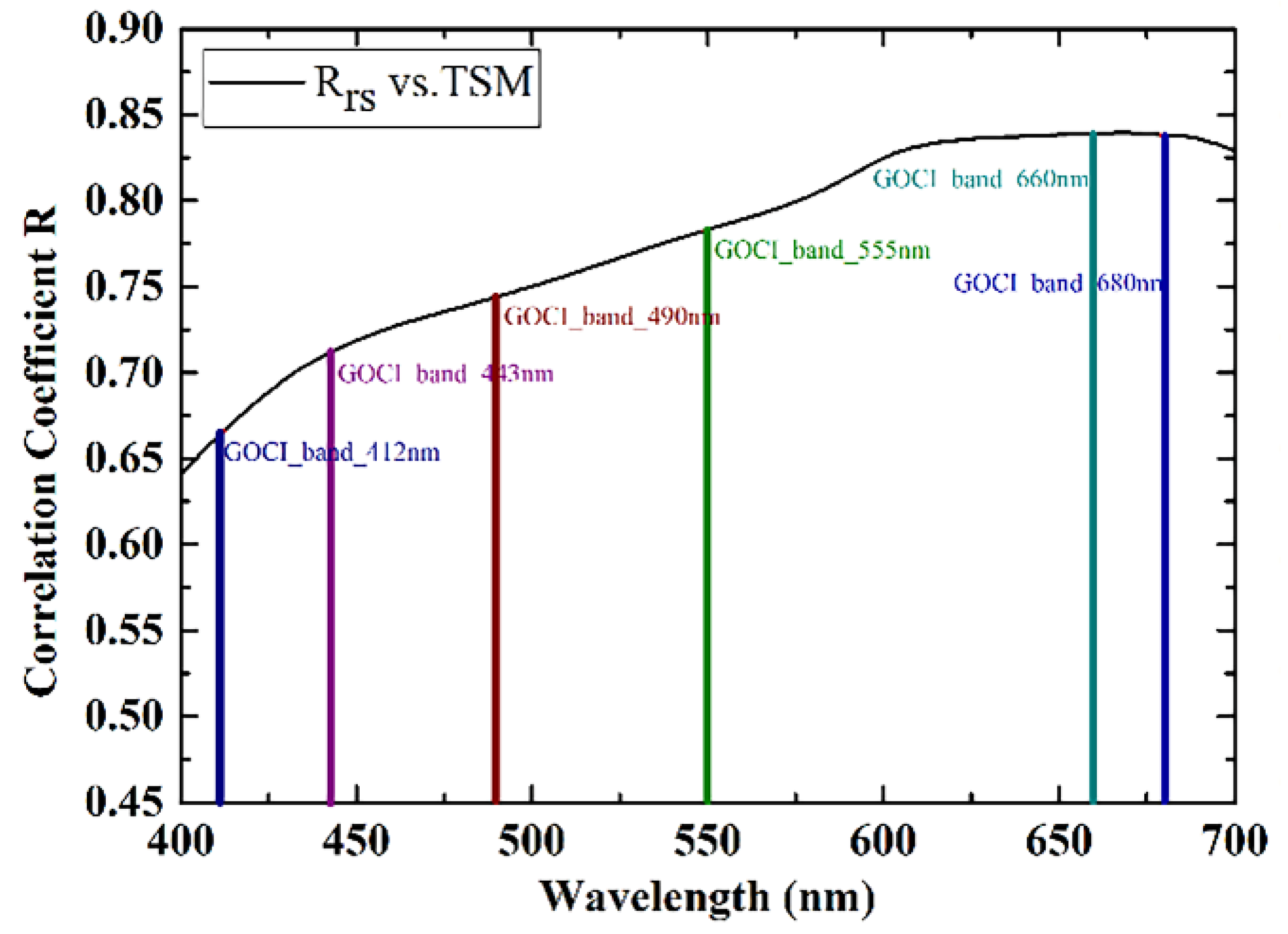
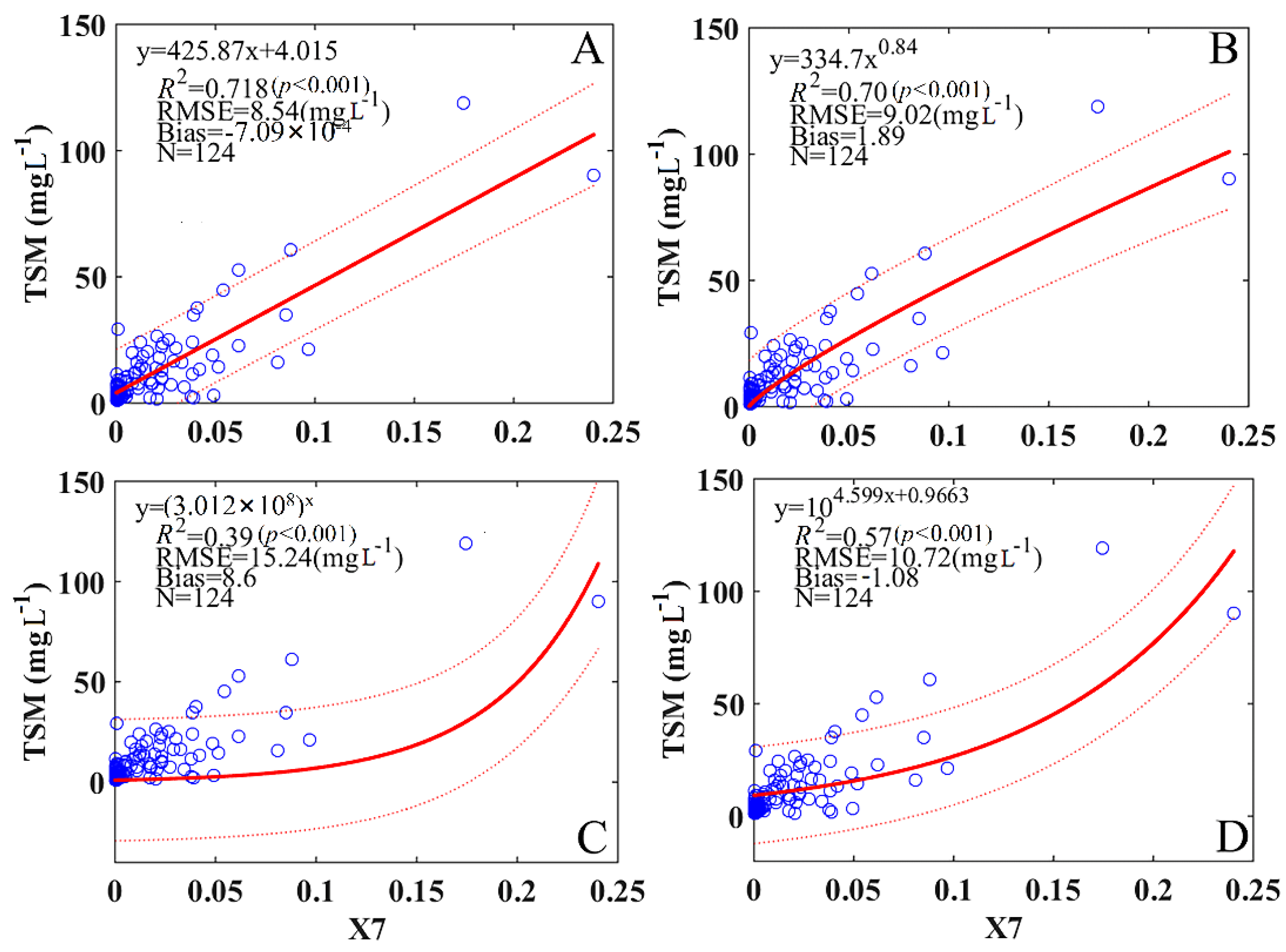
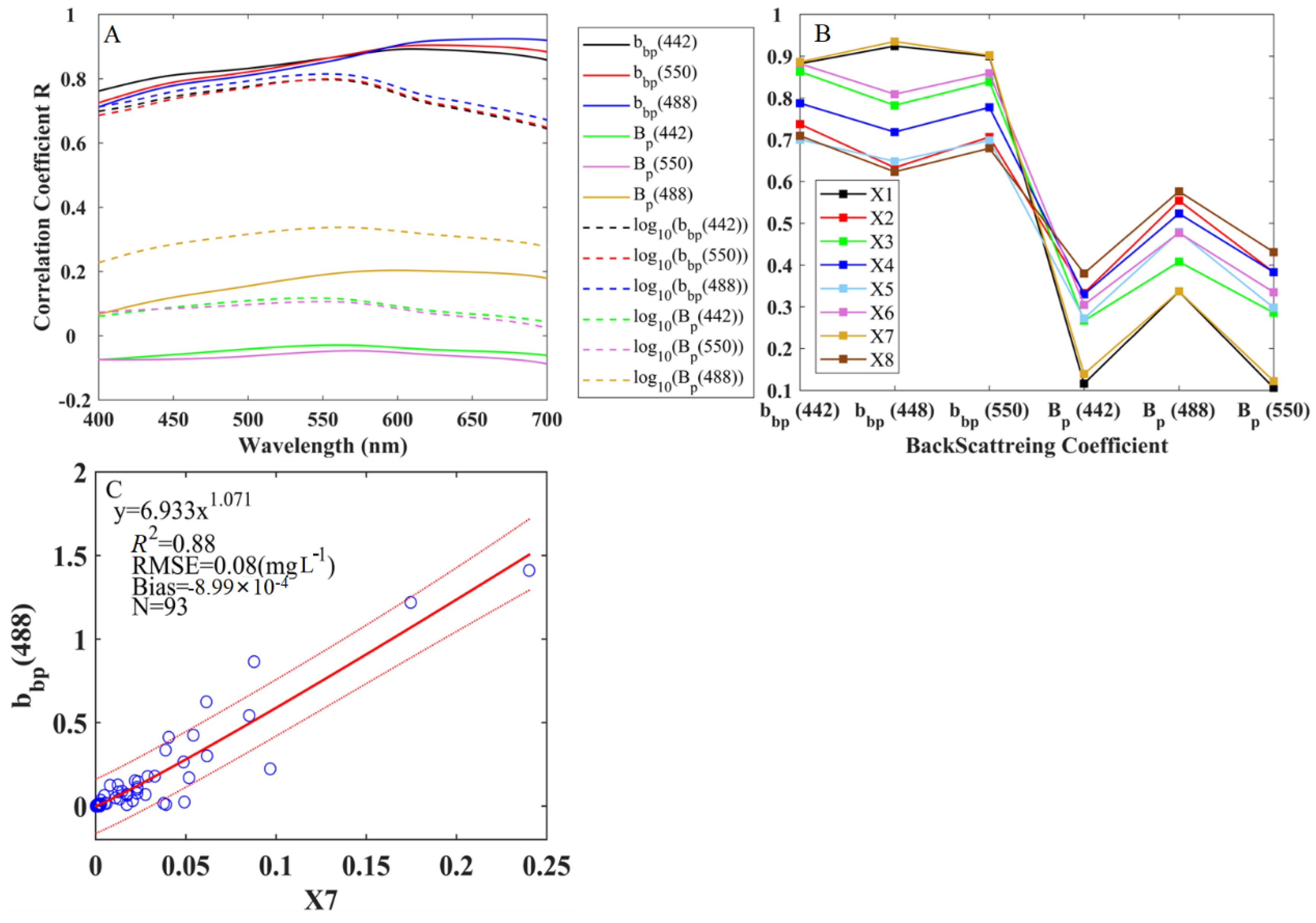
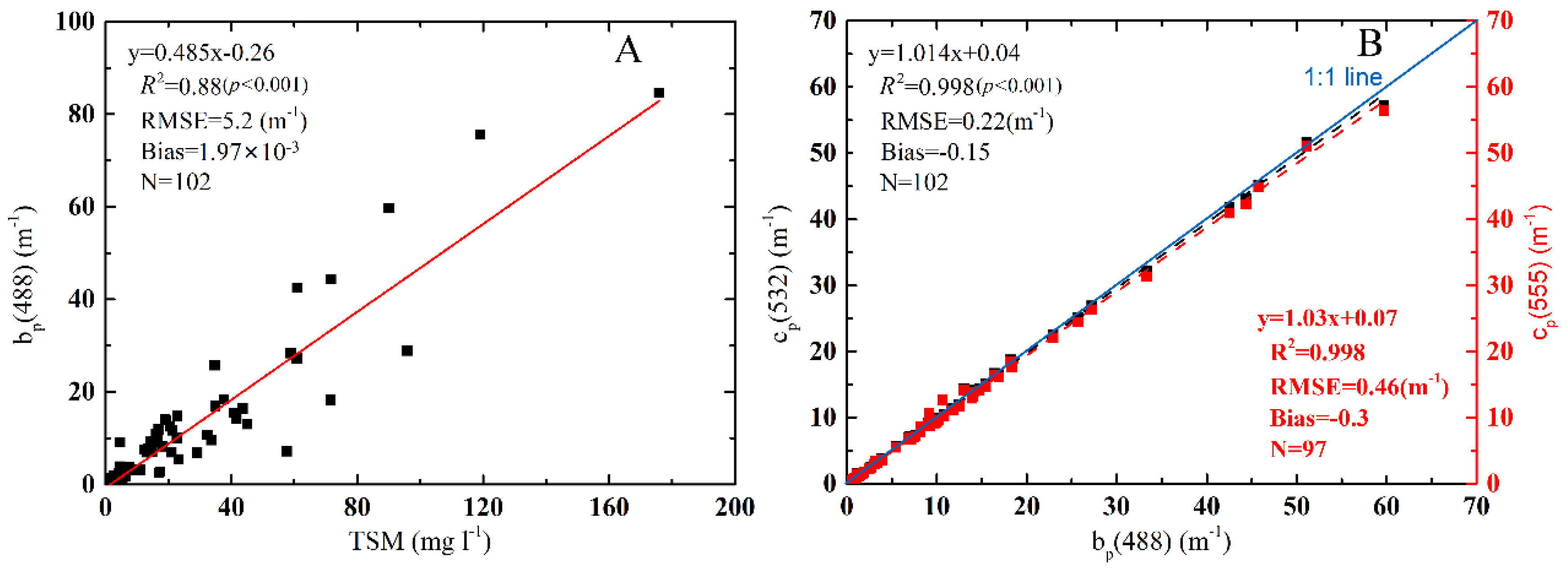
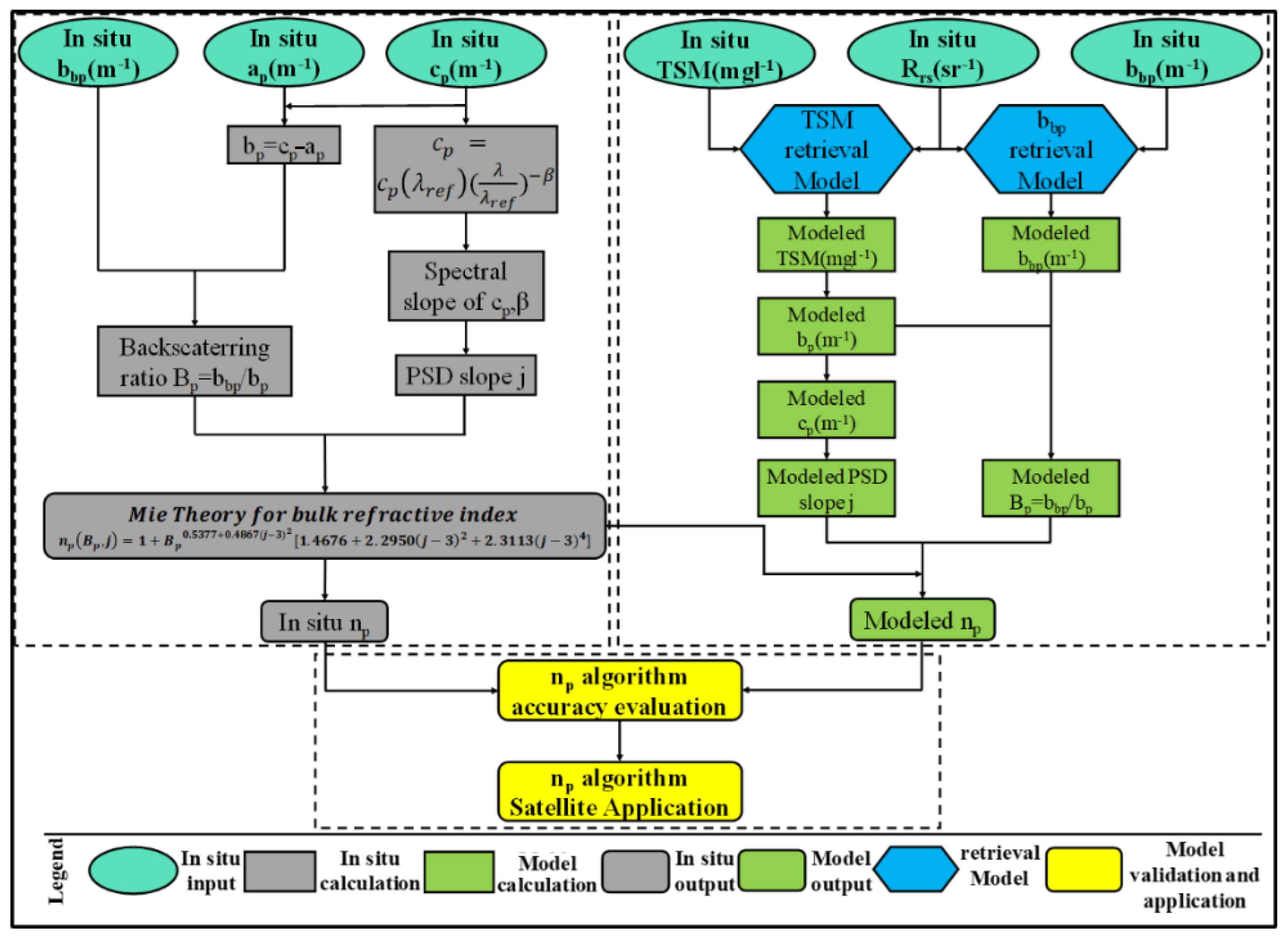
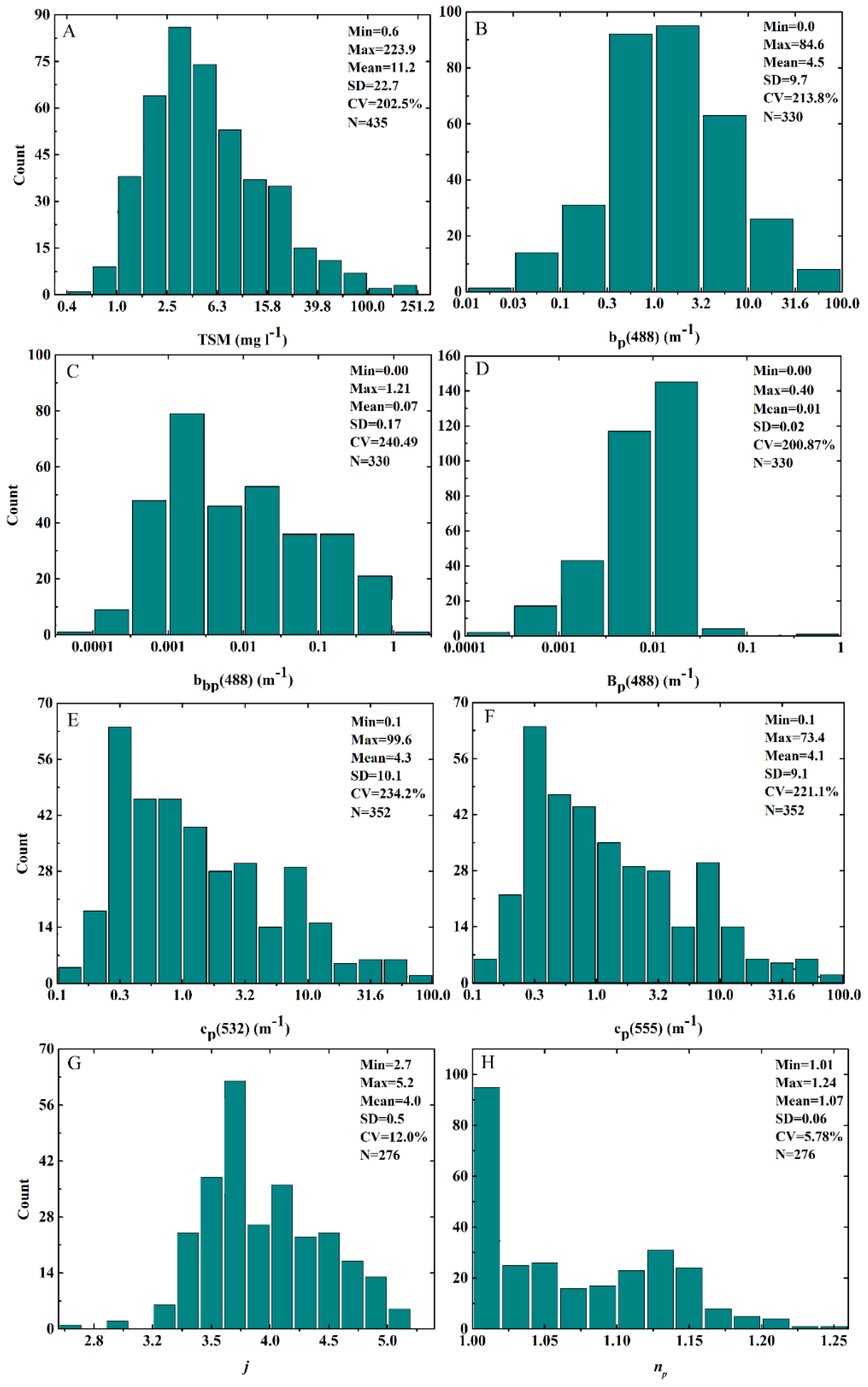
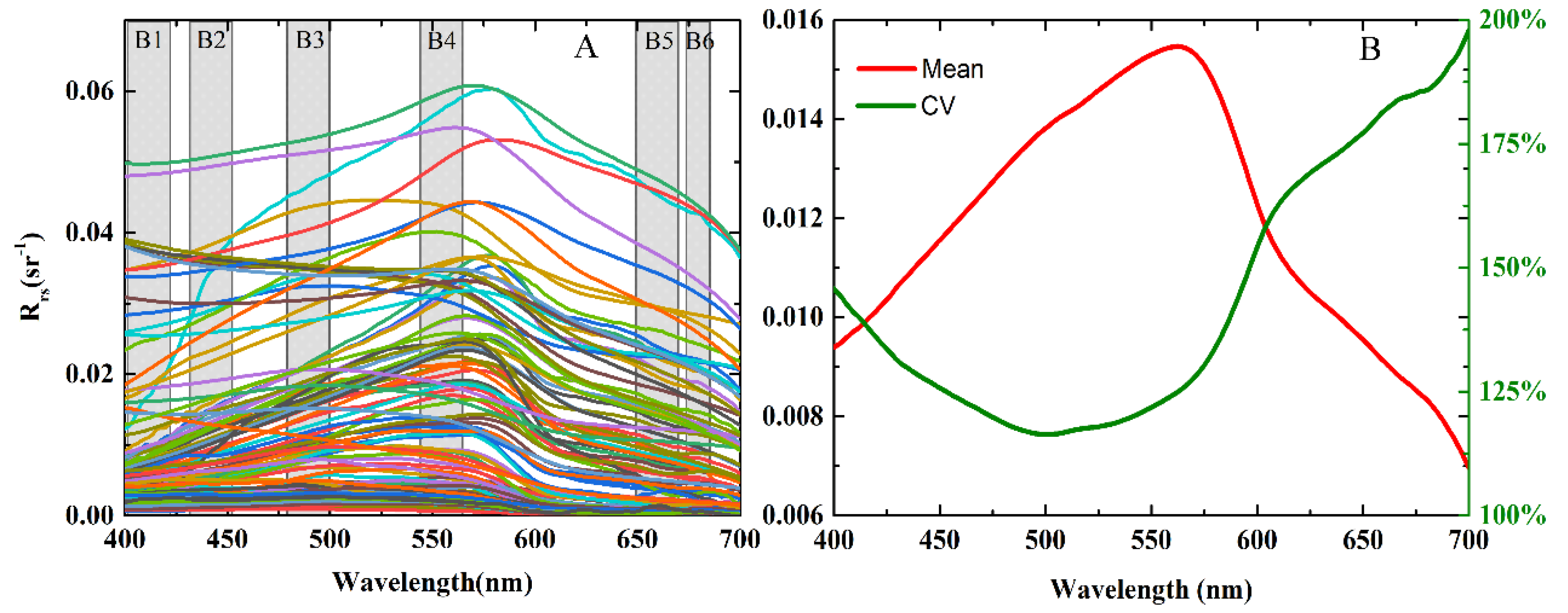


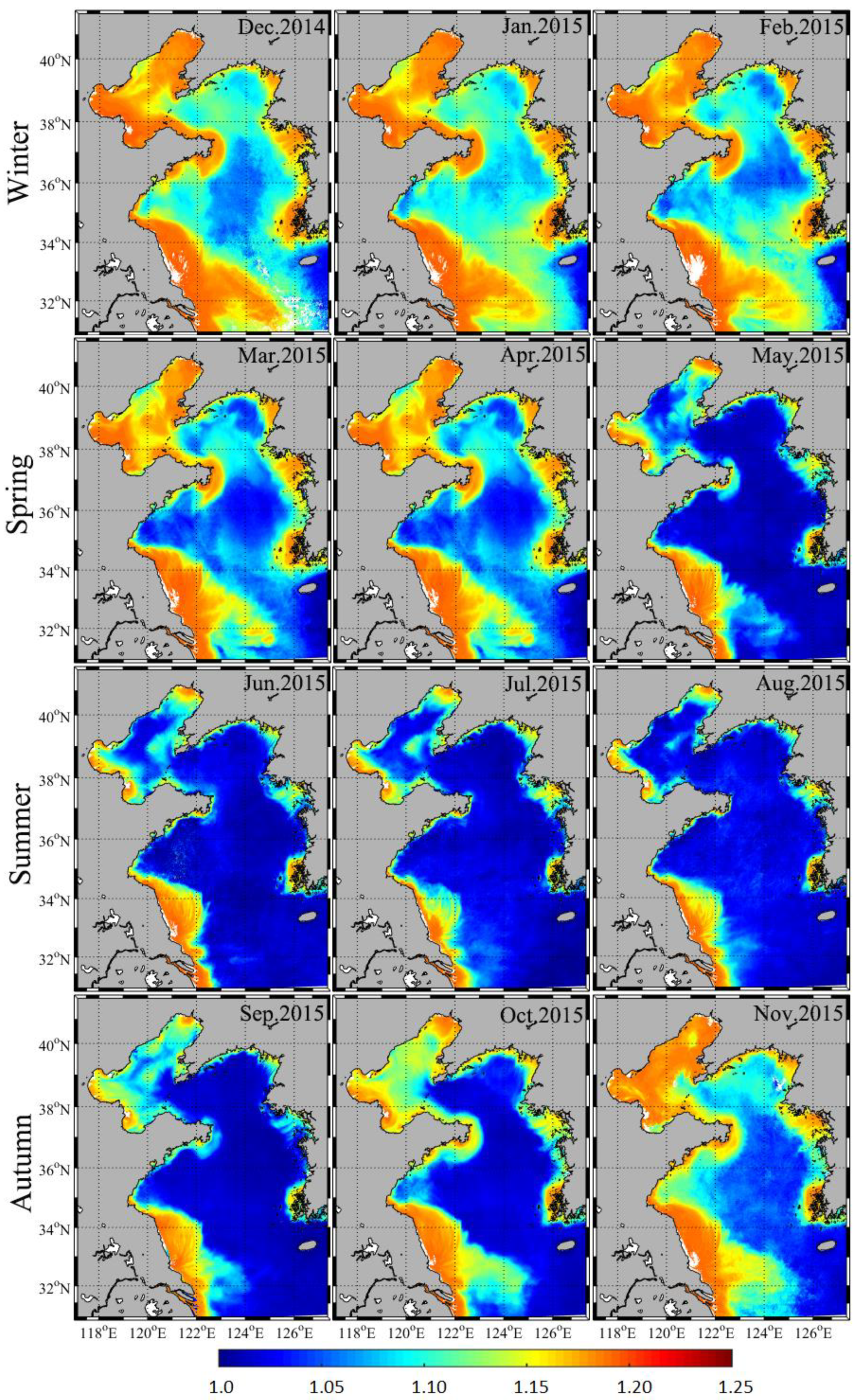


| Cruise Date | Measured Parameters | Sample Numbers |
|---|---|---|
| 7 November 2014–23 November 2014 | Rrs(λ) (sr−1) | 27 |
| TSM (mg∙L−1) | 108 | |
| 17 August 2015–5 September 2015 | Rrs(λ) (sr−1) | 37 |
| TSM (mg∙L−1) | 101 | |
| 29 June 2016–14 July 2016 | Rrs(λ) (sr−1) | 58 |
| TSM (mg∙L−1) | 123 | |
| 29 December 2016–13 January 2017 | Rrs(λ) (sr−1) | 24 |
| TSM (mg∙L−1) | 103 | |
| bbp (m−1) | 102 | |
| bp (m−1) | 102 | |
| cp (m−1) | 103 |
| X | Detailed Band Form | Optimal Band Combination | R |
|---|---|---|---|
| X1 | Rrs(λ1) | λ1 = 680 nm | 0.839 |
| X2 | log10(Rrs(λ1)) | λ1 = 680 nm | 0.588 |
| X3 | Rrs(λ1) − Rrs(λ2) | λ1 = 660 nm, λ2 = 680 nm | 0.725 |
| X4 | λ1 = 660 nm, λ2 = 555 nm | 0.606 | |
| X5 | λ1 = 490 nm, λ2 = 660 nm | 0.581 | |
| X6 | λ1 = 660 nm, λ2 = 680 nm | 0.739 | |
| X7 | λ1 = 555 nm, λ2 = 660 nm | 0.847 | |
| X8 | λ1 = 660 nm, λ2 = 555 nm | 0.555 |
© 2019 by the authors. Licensee MDPI, Basel, Switzerland. This article is an open access article distributed under the terms and conditions of the Creative Commons Attribution (CC BY) license (http://creativecommons.org/licenses/by/4.0/).
Share and Cite
Sun, D.; Ling, Z.; Wang, S.; Qiu, Z.; Huan, Y.; Mao, Z.; He, Y. A Remote-Sensing Method to Estimate Bulk Refractive Index of Suspended Particles from GOCI Satellite Measurements over Bohai Sea and Yellow Sea. Appl. Sci. 2020, 10, 23. https://doi.org/10.3390/app10010023
Sun D, Ling Z, Wang S, Qiu Z, Huan Y, Mao Z, He Y. A Remote-Sensing Method to Estimate Bulk Refractive Index of Suspended Particles from GOCI Satellite Measurements over Bohai Sea and Yellow Sea. Applied Sciences. 2020; 10(1):23. https://doi.org/10.3390/app10010023
Chicago/Turabian StyleSun, Deyong, Zunbin Ling, Shengqiang Wang, Zhongfeng Qiu, Yu Huan, Zhihua Mao, and Yijun He. 2020. "A Remote-Sensing Method to Estimate Bulk Refractive Index of Suspended Particles from GOCI Satellite Measurements over Bohai Sea and Yellow Sea" Applied Sciences 10, no. 1: 23. https://doi.org/10.3390/app10010023
APA StyleSun, D., Ling, Z., Wang, S., Qiu, Z., Huan, Y., Mao, Z., & He, Y. (2020). A Remote-Sensing Method to Estimate Bulk Refractive Index of Suspended Particles from GOCI Satellite Measurements over Bohai Sea and Yellow Sea. Applied Sciences, 10(1), 23. https://doi.org/10.3390/app10010023





